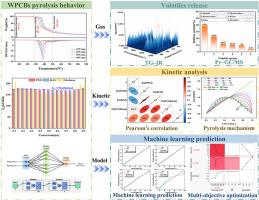废印刷电路板热解行为的机器学习驱动预测及多目标优化
IF 5.8
2区 化学
Q2 CHEMISTRY, MULTIDISCIPLINARY
引用次数: 0
摘要
预测废弃印刷电路板(wpcb)的热解行为并优化其热解参数,对于建立大规模高效的热解系统进行资源回收至关重要。本研究的重点是利用无模型方法阐明wpcb的热解机理、动力学和热重分析,并通过机器学习(ML)模型预测热解行为。采用Flynne-Walle-Ozawa (FWO)法、Kissinger-Akahira-Sunose (KAS)法和Friedman法测定表观活化能Eα,三种方法的Eα分别为175.29、174.38和170.67 kJ/mol。主图法表明,热解反应机理符合化学反应模型F3。在4个ML模型的基础上建立了质量损失预测模型,其中人工神经网络(ANN)模型表现出较好的性能(R2 = 1, MSE = 24574 × 10−4)。基于人工神经网络模型的多目标优化结果表明,500°C和10°C/min的升温速率代表了最佳运行参数,同时实现了能源效率最大化和环境影响最小化。本研究结果为wpcb的优化热解提供了基础和实用的见解。本文章由计算机程序翻译,如有差异,请以英文原文为准。

Machine learning-driven prediction and multi-objective optimization of pyrolysis behavior for waste printed circuit boards
Predicting the pyrolysis behavior of waste printed circuit boards (WPCBs) and optimizing its parameters are crucial for establishing large-scale efficient pyrolysis systems for resource recovery. This study focuses on elucidating the pyrolysis mechanism, kinetics, and thermogravimetric analysis of WPCBs using model-free approaches and predicting pyrolysis behavior through machine learning (ML) models. The apparent activation energy (Eα) was determined to use the Flynne‒Walle‒Ozawa (FWO), Kissinger‒Akahira‒Sunose (KAS), and Friedman methods, which Eα of 175.29 kJ/mol, 174.38 kJ/mol and 170.67 kJ/mol for the three methods, respectively. The master plot method indicated that the pyrolysis reaction mechanism conforms to the chemical reaction model F3. The mass loss prediction model was developed based on four ML models, with the artificial neural network (ANN) model demonstrating superior performance (R2 = 1, MSE = 24574 × 10−4). Multi-objective optimization based on the ANN model revealed that 500 °C and a heating rate of 10 °C/min represent the optimal operating parameters, simultaneously maximizing energy efficiency and minimizing environmental impact. The findings of this study provide fundamental and practical insights into the optimized pyrolysis of WPCBs.
求助全文
通过发布文献求助,成功后即可免费获取论文全文。
去求助
来源期刊

Sustainable Chemistry and Pharmacy
Environmental Science-Pollution
CiteScore
8.20
自引率
6.70%
发文量
274
审稿时长
37 days
期刊介绍:
Sustainable Chemistry and Pharmacy publishes research that is related to chemistry, pharmacy and sustainability science in a forward oriented manner. It provides a unique forum for the publication of innovative research on the intersection and overlap of chemistry and pharmacy on the one hand and sustainability on the other hand. This includes contributions related to increasing sustainability of chemistry and pharmaceutical science and industries itself as well as their products in relation to the contribution of these to sustainability itself. As an interdisciplinary and transdisciplinary journal it addresses all sustainability related issues along the life cycle of chemical and pharmaceutical products form resource related topics until the end of life of products. This includes not only natural science based approaches and issues but also from humanities, social science and economics as far as they are dealing with sustainability related to chemistry and pharmacy. Sustainable Chemistry and Pharmacy aims at bridging between disciplines as well as developing and developed countries.
 求助内容:
求助内容: 应助结果提醒方式:
应助结果提醒方式:


